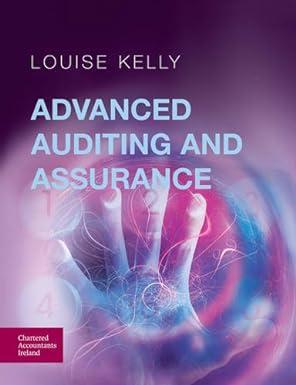Question
Please answer only question G AP 17-4 (ITA 86(1) and 86(2)) Squire Ltd. is a successful CCPC that was incorporated in Manitoba in 1986 by
Please answer only question G
AP 17-4 (ITA 86(1) and 86(2)) Squire Ltd. is a successful CCPC that was incorporated in Manitoba in 1986 by its sole shareholder and incorporator, Mr. Larry Squire. Squire Ltd. uses a December 31 taxation year end. The company was initially authorized to issue an unlimited number of two classes of common shares (Class A and B). Mr. Squire acquired 1,000 of the Class A common shares for $10.00 each, or $10,000, for that class of common shares. Mr. Squire initially financed the company with a combination of bank financing (which he had to give a personal guarantee) and an interest-free shareholder loan. In 2017 on the advice of his accountant, Mr. Squire undertook a crystallization transaction to use $290,000 of his capital gains deduction to recognize the increasing value of the company. The result of this acceptable tax planning was that Mr. Squire gave up all of his Class A common shares for Class B common shares. The 1,000 Class B common shares now owned by Mr. Squire have a PUC of $10.00 per share ($10,000 for the class of shares) and an ACB of $300 per share. By mid-2021 the value of the company has increased to the point that the FMV of the Class B common shares is $930 per share for a total FMV of $930,000. Mr. Squire wishes to retire and pass on the incorporated business to his only daughter, Amanda, who has worked alongside him since 2002 and is well versed in all aspects of the company busi-ness. He has spoken to his accountant about a business succession plan that will pass control of the company to Amanda with the least tax cost possible while allowing him to gradually remove the $930,000 value of his shares over the next fve years. He has advised his accountant that he wishes to maximize any non-share consideration such as promissory notes. Mr. Squire advises that the company currently needs all of its existing cash for working capital purposes but will generate excess cash later in 2021 and subsequent years that will be sufficient to pay him out. The shares of Squire Ltd. do not meet all of the conditions to qualify as QSBC shares, and there-fore the capital gains deduction is not a consideration in the succession planning. In addition, the company balance at year end in its GRIP account is expected to be nil and remain so into the foreseeable future. As the accountant for Mr. Squire and the company you recommend a business succession plan that will result in an estate freeze share exchange under ITA 86 that would (1) require amending the articles of incorporate to add a new class of fxed value preferred shares that will be exchanged for all of Mr. Squires Class B common shares, (2) maximize the NSC (e.g., a promissory note) received by Mr. Squire on the share exchange without income tax implications, (3) allow Amanda to acquire Class A common shares at a minimal cost, and (4) allow Mr. Squire to receive his investment value of $930,000 over the next fve years through a combination of preferred share redemptions and payments on any promissory note. Assume that Amanda acquired 100 Class A common shares for $10 each, or $1,000 in total, once the estate freeze was completed. Required:
A. If it were not for rollovers such as ITA 86, what would the income tax consequences have been had Squire Ltd. redeemed all of Mr. Squires Class B shares?
B. Determine both the maximum amount of NSC and the FMV of the preferred shares that Mr. Squire can take back on the share exchange without triggering any income tax consequences.
C. Determine the ACB and PUC of the preferred shares received by Mr. Squire on the share exchange.
D. Determine both the proceeds of redemption and proceeds of disposition as a result of Mr. Squire giving up his Class B common shares on the share exchange.
E. Determine whether the ITA 86 share exchange avoided any income tax consequences such as capital gains, capital losses, and deemed dividends using the numbers from Part D above.
F. Calculate the income tax consequences to Mr. Squire if he were to redeem all of the pre-ferred shares received on the exchange in 2022 for their FMV.
G. Assume that in 2022 the CRA decides to review the ITA 86 exchange and determines that the FMV of the Class B common shares owned by Mr. Squire was $1,500,000. Determine the same income tax implications as determined in Parts B to F above to both Mr. Squire and his daughter.
Step by Step Solution
There are 3 Steps involved in it
Step: 1

Get Instant Access to Expert-Tailored Solutions
See step-by-step solutions with expert insights and AI powered tools for academic success
Step: 2

Step: 3

Ace Your Homework with AI
Get the answers you need in no time with our AI-driven, step-by-step assistance
Get Started


